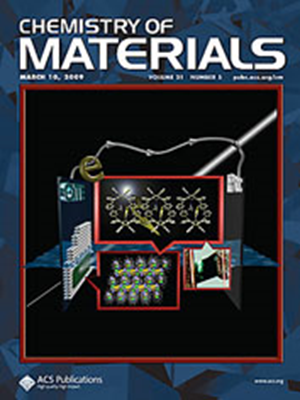Broadband Pyro-Phototronic Effect in Lead-Free Double Perovskite Crystal Enables UV-to-NIR and Polarization-Sensitive Detection
IF 7.2
2区 材料科学
Q2 CHEMISTRY, PHYSICAL
引用次数: 0
Abstract
Broadband spectral detection holds a significant promise for diverse applications in environmental monitoring, infrared sensing, and biomedicine. However, the photoresponsive ranges of most photoactive materials are often limited by the intrinsic optical bandgap, which predominantly focuses on the ultraviolet and visible spectral region, thus hindering their broadband optical applications. Therefore, achieving high-performance broadband spectral photodetection is essential for advancing various cutting-edge technologies. In this study, we have obtained a lead-free double perovskite (FPEA)4AgBiI8 (1, FPEA+ is p-fluorophenethylammonium), which has strong structural polarity and a narrow bandgap (Eg) of ∼1.80 eV. The π–π stacking of interlayer FPEA+ cations creates a robust interlayer connection that contributes to the growth of high-quality single crystals. Notably, the inherent polarity of 1 allows a broadband pyro-phototronic effect that covers a wide spectral range from the ultraviolet (UV, 377 nm) to the near-infrared (NIR, 2000 nm) region, breaking the limitation of its optical bandgap. This unique pyro-phototronic effect significantly enhances the photoelectric performance of 1, of which the photopyroelectric peak current at 637 nm illumination is 427% larger than the photovoltaic current. Additionally, combining the advantages of structural anisotropy and pyro-phototronic effect, the crystal-based device of 1 creates superior polarization-sensitive photodetection behaviors. This study not only enriches the portfolio of photoactive perovskite candidates but also provides an effective strategy for assembling high-performance optoelectronic devices.

无铅双钙钛矿晶体的宽带热光电子效应使紫外-近红外和偏振敏感检测成为可能
宽带光谱检测在环境监测、红外传感、生物医学等领域有着广阔的应用前景。然而,大多数光活性材料的光响应范围往往受到固有光学带隙的限制,主要集中在紫外和可见光谱区域,从而阻碍了它们的宽带光学应用。因此,实现高性能宽带光谱光探测对于推进各种前沿技术至关重要。在本研究中,我们获得了一种无铅双钙钛矿(FPEA)4AgBiI8 (1, FPEA+为对氟苯乙基铵),其结构极性强,带隙(Eg)窄,约为1.80 eV。层间FPEA+阳离子的π -π堆叠创造了一个强大的层间连接,有助于高质量单晶的生长。值得注意的是,1的固有极性允许宽带热光电子效应,覆盖从紫外(UV, 377 nm)到近红外(NIR, 2000 nm)区域的宽光谱范围,打破了其光学带隙的限制。这种独特的热敏光电子效应显著提高了1的光电性能,其中在637 nm光照下的光电峰值电流比光伏电流大427%。此外,结合结构各向异性和热光电子效应的优势,晶体基器件1具有优越的偏振敏感光探测行为。该研究不仅丰富了光活性钙钛矿候选材料的组合,而且为组装高性能光电器件提供了有效的策略。
本文章由计算机程序翻译,如有差异,请以英文原文为准。
求助全文
约1分钟内获得全文
求助全文
来源期刊

Chemistry of Materials
工程技术-材料科学:综合
CiteScore
14.10
自引率
5.80%
发文量
929
审稿时长
1.5 months
期刊介绍:
The journal Chemistry of Materials focuses on publishing original research at the intersection of materials science and chemistry. The studies published in the journal involve chemistry as a prominent component and explore topics such as the design, synthesis, characterization, processing, understanding, and application of functional or potentially functional materials. The journal covers various areas of interest, including inorganic and organic solid-state chemistry, nanomaterials, biomaterials, thin films and polymers, and composite/hybrid materials. The journal particularly seeks papers that highlight the creation or development of innovative materials with novel optical, electrical, magnetic, catalytic, or mechanical properties. It is essential that manuscripts on these topics have a primary focus on the chemistry of materials and represent a significant advancement compared to prior research. Before external reviews are sought, submitted manuscripts undergo a review process by a minimum of two editors to ensure their appropriateness for the journal and the presence of sufficient evidence of a significant advance that will be of broad interest to the materials chemistry community.
 求助内容:
求助内容: 应助结果提醒方式:
应助结果提醒方式:


